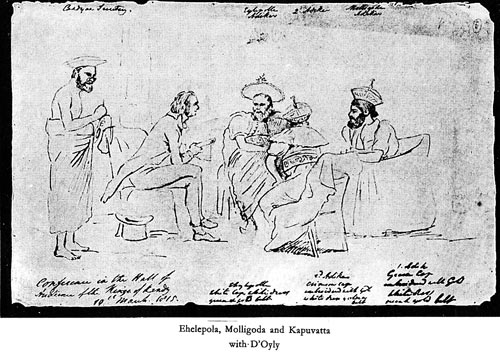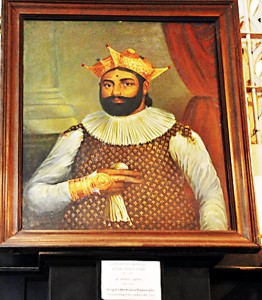200 years ago the British marched into Kandy
In early February 1815, British troops entered Kandy after a month-long advance from the coastline. Unlike previous invasions, the troops were led this time by the dedicated British civil servant, John D’Oyly, rather than a military officer. From all accounts of the invasion D’Oyly’s remit was extraordinarily wide and he had two immediate objectives: first, to occupy the kingdom and its capital; second, to capture and depose the King Sri Wickrama Rajasingha.

The King’s nemesis John D’Oyly confers with the Adigars in the sketch above. Source: Wikipedia
The first objective was accomplished easily enough and the British troops passed through all sides of the Kandyan kingdom unopposed, facilitated partly by the defection of the king’s chieftains. The troops’ long march through the kingdom culminated on February 12, 1815, with a tour of the palace area by a detachment of the 2nd British division with John D’Oyly, attired in a white coat, taking the lead.
In customary fashion, the king had retreated with his family into the mountains and his subjects had followed suit leaving behind “the city entirely deserted and Houses destitute of all Property except for mats, baskets and chatties…” as D’Oyly noted in his journal. In the palace itself, D’Oyly noted that there were broken chests, boxes and rubbish in abundance lying around suggesting a measure of haste. The only defenders of the capital were the street dogs, whose breed had a reputation of loyal but futile resistance that was even noted centuries before during the first Portuguese invasion.
The unfolding of the lovely dawn of conquest for the British is published in Charles Taylor’s extract of a letter in the Literary Panorama and Register a year later. The elated author describes how the British Governor Brownrigg arrived on February 14 and occupied the ornate room that was used by the king at the top of the octagonal tower. The author himself occupied the room below connected by a flight of steps leading down from a trap door. He then exulted at the vista from the balcony of the Octagon as “an amphitheatre of hills on all sides, a spacious tank (the lake) with a summer house in the middle and two royal residences on the opposite side.” Interestingly this account mentions the Mudliyar (lowland Sinhalese aristocrat) W. Adrian Dias who had arrived with the British as an interpreter and who gave them an overview of the capital’s history.
Meanwhile, D’Oyly devoted his energy to finding the king. By February 18, D’Oyly recorded that there were reports of the king inMedamahanuwara, a township not far from Kandy – a precise piece of intelligence as it turned out. A search party of about 500 men led by the chieftain Eknelligoda set out on the same day accompanied by Adrian Dias. Much of the day was uneventful, but legend has it that close to 5 p.m., a terrified boy was spotted running and there was something frantic in his manner that caught the attention of the men who gave chase.
A dramatic turn of events followed and made up for any dreariness experienced so far. Upon apprehending the boy, he volunteered the startling information that the king was nearby in the home of Udupitiya, a minor chieftain. The search party then descended upon the home and saw the royal palanquin in the backyard where two women were pounding rice in a mortar. Udupitiya himself was seen pacing in the garden with a spear in hand. As the party approached, he hurled the lance narrowly missing Eknelligoda and it splintered against a rock. He was then seized and taken to a fate unrecorded, while the two women fled shrieking for safety. A palace steward peered from within the house through an aperture just below a gutter and was shot dead. This was the last man to die for the king of Kandy.
Eknelligoda made his way to the front door barricaded from within and knocked. There was no response but two daggers and three guns were thrown through a vent above the door – a gesture of surrender. Not content, Eknelligoda then demanded that the ceremonial sword of state be thrown out as well – a gesture of abdication, but there was no response forthcoming. Then, the men used the barrel-like mortar to batter down the door urged on by Eknelligoda to “capture that murderer of women and children” – an obvious reference to the Ehelepola family’s execution in 1814 that had served to estrange the king from his subjects.
In a horde they swooped through the house and fell upon the king with a vengeance. The two queens with him were not spared and the nose ring of one queen was ripped off while the other queen had her earrings ripped off in similar manner (and her blood stained jacket remains on display at the Colombo museum). They were then forced outside where the queens clung to Adrian Dias who remonstrated with the mob reminding them that they once considered their king a god, only to be silenced by Eknelligoda.
Then regaining his composure, Dias hastily scribbled a note: “To General D’Oyly…the Sinhalese king has fallen into our hands and Eknelligoda …is fetching him on and has bound him and is subjecting him to much ill treatment and ignominy….some wearing apparel is also necessary as the queens are almost naked.” Brief and urgent as it was, this note recorded an immensely historic moment –2,357 years of the traditional monarchy was coming to an end.
Upon receiving the information, a body of 150 British troops was dispatched under Major Hook. Arriving at the scene they found Eknelligoda and his followers along with their royal captive in a field. The king, looted of his valuables, was bound with thorny creepers that left scars on his forearms and was subjected to much verbal abuse. The only other physical abuse inflicted though was a kick delivered from Eknelligoda with orders to start moving towards the road to Kandy. Eknelligoda’s irreverent act, according to legend, stigmatised him with a persistent skin affliction around the ankle of the offending foot.

The last king of Kandy, Sri Wickrama Rajasinha’s portrait in the Kandy museum (Copyright Brian J. McMorrow 1999-2012)
The British troops had to use whips to disperse the mob and took the king into their custody. They then unbound the king and assured him of his safety along with that of his queens– something the king little expected to happen. A palanquin arrived for the king and the British troops formed two columns on either side to escort him and the queens to their encampment nearby. In addition, two officers riding on horseback with their swords drawn flanked either side of the palanquin as the day drew to a close.
Meanwhile, D’Oyly who was overseeing operations at Teldeniya on the outskirts of Kandy, received the news and went forward to meet the king on February 19 to conduct the royal persons back. For D’Oyly this was the crowning achievement of his career and the king thus met his nemesis, quite literally. Though likely aware of D’Oyly’s capabilities from their previous indirect dealings, the king was probably comforted that D’Oyly could converse fluently with him in Sinhala to reassure the royal family’s safety under British custody.
D’Oyly then penned the letter of a lifetime to the Governor who was in Kandy. Betraying some emotion, he expressed his “sincerest joy….that the Object of your anxious wishes is accomplished and the King of Kandy a Captive in our Hands”. It was a remarkable moment in the history of the nation. For the first time a king of Kandy was taken captive and the entire epoch of an unyielding kingdom was drawing to its close. The Governor who was at dinner with his officers that evening was visibly moved to tears on receiving the letter, according to Dr. Marshall who was seated near him. Then realizing the enormity of the moment, he rose to make the announcement and proposed a toast to King George III – essentially the new king of Kandy.
The royal party remained at Teldeniya, joined by the king’s mother and his other two queens. D’Oyly interviewed the king who complained at the insulting language heaped by his captors who were his subjects after all, but appeared otherwise to have regained his stride. The king also offered to disclose the whereabouts of the royal treasure, earning a reprimand from D’Oyly that it would not be a mitigating factor if the offer was personal. It was the king’s first experience with the British civil service’s style of impartial accountability – something he began to admire all too late during his captivity.
The fallen king never returned to his capital. The British feared that the only sensation it would produce would be one of exasperation. Judging from the events at his capture, this fear seemed well placed. Far more telling was that the deportation of the king did not evoke any trace of the valiant resistance with which the kingdom had defended itself against three centuries of European invasion. By contrast, his subjects seemed unmoved by his downfall.
In the aftermath of the king’s exile, D’Oyly remained in Kandy and devoted his energies to obtaining a treaty that formally ceded the kingdom to the British crown. His diary records several interviews he conducted with the Kandyan chiefs and clergy. The only known illustration of D’Oyly shows him in earnest discussion with three Kandyan chiefs: presumably the former Adigar Ehelepola, the incumbent Adigar Molligoda and the deputy Adigar Kapuwatte while a scribe stands in the background. A less evident fact is that all of them were participating in the Sinhala language. The treaty itself was formalised in the Kandyan convention held on March 2, 1815 in the Audience Hall of the palace and ratified by the king’s chieftains and the British Governor. With that the kingdom transited into a colony and the glorious Kandyan era was all but over.


